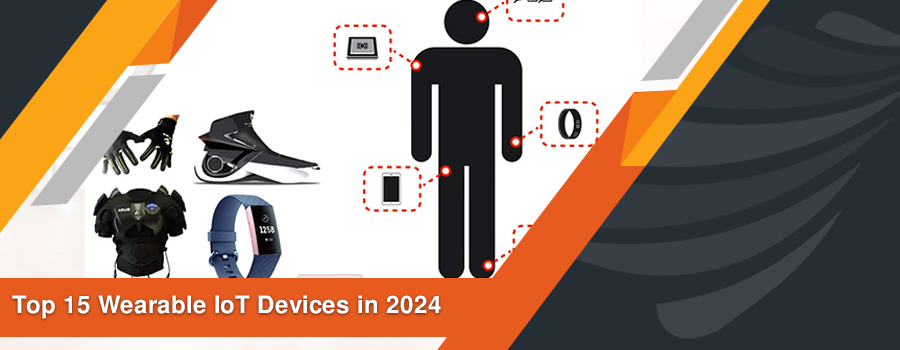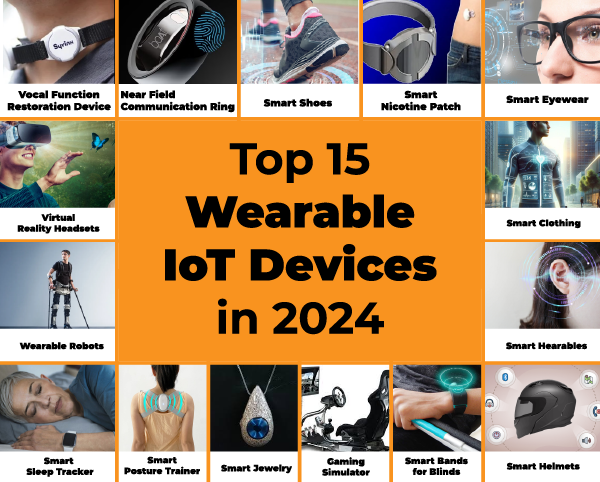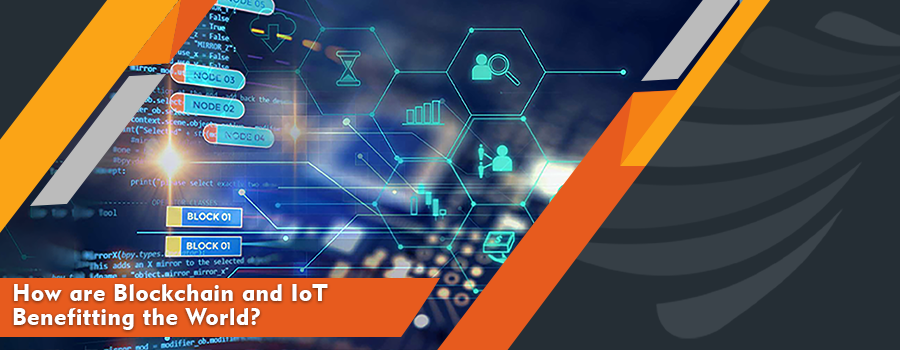Whether you like it or not, IoT-enabled wearable technology has replaced all those devices that need extensive handling and safety. Easy-to-wear devices with many features are the most popular and demanding among the present generation.
IoT-enabled wearable devices are not now a trend but have become an integral part of adopting a healthy and updated lifestyle. Every year, we see new improvements and innovations in wearable devices, so here we are to uncover the latest top 15 IoT wearable devices that will make your life healthy, safe, and active.
Stay connected with us if you are curious about the future of wearables. We guarantee that you will be amazed and inspired till the end of this article by learning about all the latest inventions that can completely change your life.
Market Trends of Wearable IoT Devices
The market for wearable IoT devices is still growing, and it’s one of the major trends in the wider field of IoT innovation. IoT is gaining traction across a wide range of businesses, and last year alone, global spending on wearable technology reached $81.5 billion, an astounding 18% rise from 2020. Forecasts suggest that this upward trend will continue, with spending predicted to reach over $90 billion by 2022.
Companies that stay aware of how IoT wearable technologies are developing could have a big competitive advantage. Businesses may make data-driven decisions that increase productivity and efficiency by using wearable technology to gather accurate and useful data. Furthermore, these technologies present unmatched chances to raise customer acquisition and retention rates. Businesses may establish themselves as leaders in their field and provide customers with an exceptional experience by providing a range of cutting-edge features and services.
With a predicted market size of USD 265.4 billion by 2026, the worldwide wearable technology industry is expected to continue its remarkable growth trajectory. This increase highlights the enormous potential of wearable IoT devices in influencing business and technology, with a compound annual growth rate (CAGR) of 18.0% over the forecast year. Interestingly, the measured growth rate in only 2022–2021 was 41.51%, demonstrating how quickly innovation and adoption occur in this exciting market category.
Top 15 Wearable IoT Devices in 2024
The wait is over; here you are to learn about the top 15 wearable IoT devices to explore in 2024:
1. Vocal Function Restoration Device
Voice disorders affect individuals across all age groups and demographics. Research has shown that around 30% of individuals will suffer at least one such disorder in their lifetime. Surgical interventions and voice therapy are therapeutic approaches for voice recovery, but the period can stretch from three months to one year. Existing solutions are invasive and, therefore, uncomfortable and inconvenient for patients.
The vocal function restoration wearable device represents a monumental step toward addressing the challenges people with voice disorders face. It is a non-invasive, wearable solution that assists individuals in communicating effectively during both pre-treatment and post-treatment recovery periods.
With machine learning technology, it detects larynx muscle movements and translates them into audible speech. With 90% accuracy, this device allows users to express a wide range of phrases and words, empowering them to communicate in different situations proficiently.
2. Near Field Communication (NFC) Ring
The NFC smart ring is a versatile and convenient wearable device with various functionalities. It uses NFC technology to provide contactless payment, information sharing, and door access. Consolidating essential cards and keys into a single wearable device relieves you from the burden of carrying and managing multiple physical items, making your daily routine simpler, more streamlined, and less stressful.
Additional features like automatic running, program lock, and business card sharing add further utility to this smart ring, enhancing its usefulness and practicality. Also, when connected to a smartphone, you get notification alerts and can make phone calls, making it a comprehensive wearable solution and allowing you to stay connected and updated.
3. Smart Shoes
Now, you can have smart shoes that monitor your health activities, activity levels, and blood pressure and provide a perfect fit and optimal comfort. With their electric and adaptable reaction lacing technology, these shoes adjust to the shape of your foot, alleviating discomfort and swelling. These smart shoes are a reliable and comfortable solution for people with foot conditions and those involved in excessive physical activity.
Smart shoes also provide personalized feedback on health metrics like calorie burns, steps, posture, and fatigue, allowing you to easily keep track of your fitness progress and make informed decisions about your health and lifestyle.
4. Smart Nicotine Patch
Nicotine dependence is common, affecting around 23.6 million American citizens and 8.5% of people older than 11 years. The smart nicotine patch is a promising wearable IoT technology that supports individuals who are striving to overcome nicotine addiction, particularly present in cigarettes. Nicotine replacement therapy is often given through patches, and it is a recognized method for gradually reducing dependency on nicotine and cigarettes.
The integration of IoT capabilities in nicotine patches allows real-time monitoring of nicotine levels and smoking habits. IoT integration helps to provide personalized therapy, coaching, and support for quitting smoking.
The connectivity features enabled via mobile app or Bluetooth further enhance the effectiveness of the smart nicotine patch, facilitating undisturbed communication between user and device. Real-time notifications and alerts delivered via the app are reminders to stay committed to quitting.
5. Smart Eyewear
Smart eyewear transforms traditional eyeglasses into multifunctional devices. Smart eyewear offers features like augmented reality applications, heads-up displays, and hands-free communication capabilities.
IoT integration, powered by a miniaturized display, provides real-time information directly within your line of sight. Audio integration via small speakers or bone conduction allows hands-free communication, whereas wireless connection allows seamless pairing with smartphones and other devices.
Voice control features, cameras, and sensors installed in smart eyewear make different life activities easy. Augmented reality for navigation, gaming, remote communication, and health monitoring provides diverse applications that are easy for users to use.
6. Virtual Reality Headsets
An IoT headset coupled with virtual reality (VR) technology provides a dynamic combination of linked functions and immersive experiences. You can uniquely engage with virtual environments by utilizing IoT sensors and devices to manage smart home appliances or access real-time data streams. This integration creates new opportunities for data visualization, training simulations, gaming, and online collaboration through improved personalization, interactivity, and remote monitoring.
The headset’s sensors monitor your movements and environment. This allows the headset to modify the room’s illumination to match the virtual environment, creating an incredibly immersive experience. The headset may also link to smart furniture, automatically modifying its shape to fit your virtual environment.
7. Smart Clothing
Smart clothing represents a revolutionary category of wearable IoT devices where technology integrates into everyday garments. Embedded with microelectronics, sensors, and conductive fabrics, these garments can monitor biometric data such as heart rate, activity level, and body temperature in real-time.
Smart clothing offers functionalities like haptic feedback for navigation and posture correction. Moreover, smart clothing can be infused with cooling fabrics or heating elements, automatically adjusting your body temperature for optimal comfort every season.
It easily connects with smartphones and other devices via Bluetooth and provides personalized insights into your health and fitness, allowing you to manage your lifestyle proactively.
8. Wearable Robots
Wearable robots, or exoskeletons, combine humans and robots into one integrated system designed to augment human physical capabilities. They comprise sensors, actuators, and mechanical structures interacting with the wearer’s body to increase mobility, strength, sensory perception, and endurance. With powered assistance, wearable robots allow different body parts, like arms or legs, to perform specific tasks that would be impossible otherwise. Wearable robotic systems have applications ranging from medical rehabilitation to physical assistance for people with mobility impairments, such as lifting heavy objects and reducing fatigue in daily tasks.
Also, wearable robots reduce the burden on therapists by augmenting and facilitating therapeutic tasks. For example, wearable robotics assist individuals in walking and standing after a spinal cord injury or stroke. It also has innovative applications like remote cooperation, which allows telepresence in which the wearer’s movements are translated remotely into actions like controlling a robotic arm, allowing collaborative tasks from a distance with precision and ease.
9. Smart Hearables
The next step forward in wireless audio technology is smart hearables. With smart capabilities and user-friendly controls, wearables go beyond the fundamental features of standard earbuds. These gadgets provide accessibility and convenience with features like quick pairing via near-field communication and compatibility with digital assistants like Bixby, Google Assistant, Alexa, and Siri. Furthermore, first-generation wearables include integrated health biometric features and fitness tracking, enabling users to easily monitor their well-being.
Prominent technology corporations such as Apple, Philips, Samsung, and Sony have recently unveiled innovative wearable technology, demonstrating this burgeoning industry’s swift expansion and development. Samsung’s Gear IconX, for example, functions as a personal running coach and gives users immediate feedback on their fitness activities through their ears. In the meantime, Sony’s WF-1000X raises the bar for audio quality with its cutting-edge noise cancellation and sound isolation capabilities, which adapt to surrounding noises to improve safety when engaging in activities like walking.
10. Smart Sleep Tracker
Wearable sleep trackers range from wristbands and smartwatches to sensor clips and headbands. With consumer sleep technology, these gadgets not only serve as fitness trackers but also record a variety of biosignals such as temperature, skin conductance, motion, and heart rate variability to gather information regarding sleep patterns. Their accessibility via cloud-based platforms, affordability, and user-friendly mobile interfaces make them valuable tools for improving health and sleep patterns.
These devices also provide easy access to unprecedented behavioral and sleep data gathered over time in the users’ natural surroundings. Wearable sleep trackers make data gathering easier than traditional sleep studies since they don’t require specialist personnel for data processing or high levels of user participation. Rather than interfering with daily activities, you can wear gadgets to collect continuous data gathering and processing and benefit from insightful information about sleep patterns and behaviors.
11. Smart Posture Trainer
A wearable smart posture trainer is an efficient alternative for individuals who suffer from slouching when seated. This upper back device monitors any variations in posture and sends out mild warnings via vibration alerts. Its waterproof qualities and lightweight, compact design ensure smooth incorporation into daily activities.
With Bluetooth technology, this smart trainer easily connects to smartphones, simplifying setup and providing real-time posture tracking through a dedicated mobile app. You can input your physical characteristics to personalize your posture monitoring experience. After calibration, the device quietly alerts you about bad posture, encouraging better alignment and postural habits.
12. Smart Jewelry
We usually wear jewelry for fashion, but now you can wear jewelry to experience smart features. IoT-enabled wearable technology offers a unique blend of smart functionality and stylish design. Wearable smart jewelry devices can encompass accessories like rings, bracelets, and lickers. These devices can monitor activity levels and sleep patterns while providing insights into stress levels. Other smart features include notification alerts, fitness tracking, and payment capabilities. Additionally, you can track menstrual cycle tracking capabilities, allowing you to manage your reproductive health effectively.
Moreover, wearing smart jewelry can trigger alarms and pause reminders to encourage daily movement. You can also connect your jewelry with your loved ones. In an emergency, you can press the button to alert them that you need help, enhancing your safety and especially helping people with cardiac issues or epilepsy. Also, the waterproof design makes them suitable for daily wear and allows you to wear them underwater or during the shower.
13. Gaming Simulator
Wearable gaming devices present a novel way to interact with games if you want more immersion. These gadgets improve tactile engagement and sensory feedback by seamlessly blending in with the game.
Consider smart wristbands that facilitate gesture control by identifying motions and converting them into actions within the game. These gadgets use built-in sensors to record muscle movement, allowing you to manipulate virtual avatars with organic motions.
Advanced gaming simulators offer multi-sensory feedback, including vibrations, surround sound, and muscle stimulation. This immersive experience improves your gaming experience by enabling you to sense the effects of in-game actions, hear directional signals, and feel genuine sensations.
14. Smart Bands for Blinds
The prevalence of people with distance visual impairment is 3.44%, of whom 0.49% are blind. To support these individuals, we must provide innovative solutions to enhance their independence and mobility. Integrating IoT in wearable devices can emerge as innovative solutions to enhance the quality of life of visually impaired people.
One notable development includes the development of smart bands for blinds that improve the mobility of blind individuals. One example is the Toyota wearable band that you can wear near the shoulder, and with the use of a camera and sensors, it detects surroundings and identifies signs. With noise and vibration feedback, this device provides real-time information about the surrounding environment, aiding navigation and obstacle avoidance. Its advanced features include object identification, facial recognition, and mapping. Also, it provides comprehensive feedback on obstacles from floor to head level, including surface gaps and textures, providing enhanced user experience and safety for visually impaired persons.
15. Smart Helmets
Smart helmets offer riders increased protection and connectivity, a major technological and safety breakthrough. These helmets combine several elements to enhance riding enjoyment and guarantee cyclists’ safety while traveling.
Built-in communication technology is one of the main characteristics of smart helmets, enabling bikers to stay in touch while riding. IoT integration allows riders to send real-time alerts in emergencies like accidents or mechanical issues in their bikes to get immediate help and avoid critical situations. Moreover, integrated Bluetooth capabilities help bikers stay informed and amused without diverting their attention from the road.
Smart helmets also offer hands-free calling, music streaming, real-time alerts of weather conditions, and voice navigation. Furthermore, integrated sensors and safety features are frequently found in smart helmets to improve rider visibility and awareness. The helmet’s integrated LED lights, turn signals, and brake lights improve visibility to other drivers and enhance overall safety, particularly at night or in poor light. Some advanced smart helmets have integrated cameras to record rides for documentation and additional security.
To Sum Up
Wearable IoT devices are rapidly evolving, reshaping industries and customer experiences. In one device, users get different features like health monitoring, real-time alerts, and fitness tracking. From enhanced connectivity to convenience and safety, these devices provide numerous benefits; therefore, they are getting huge attention from a huge audience.






